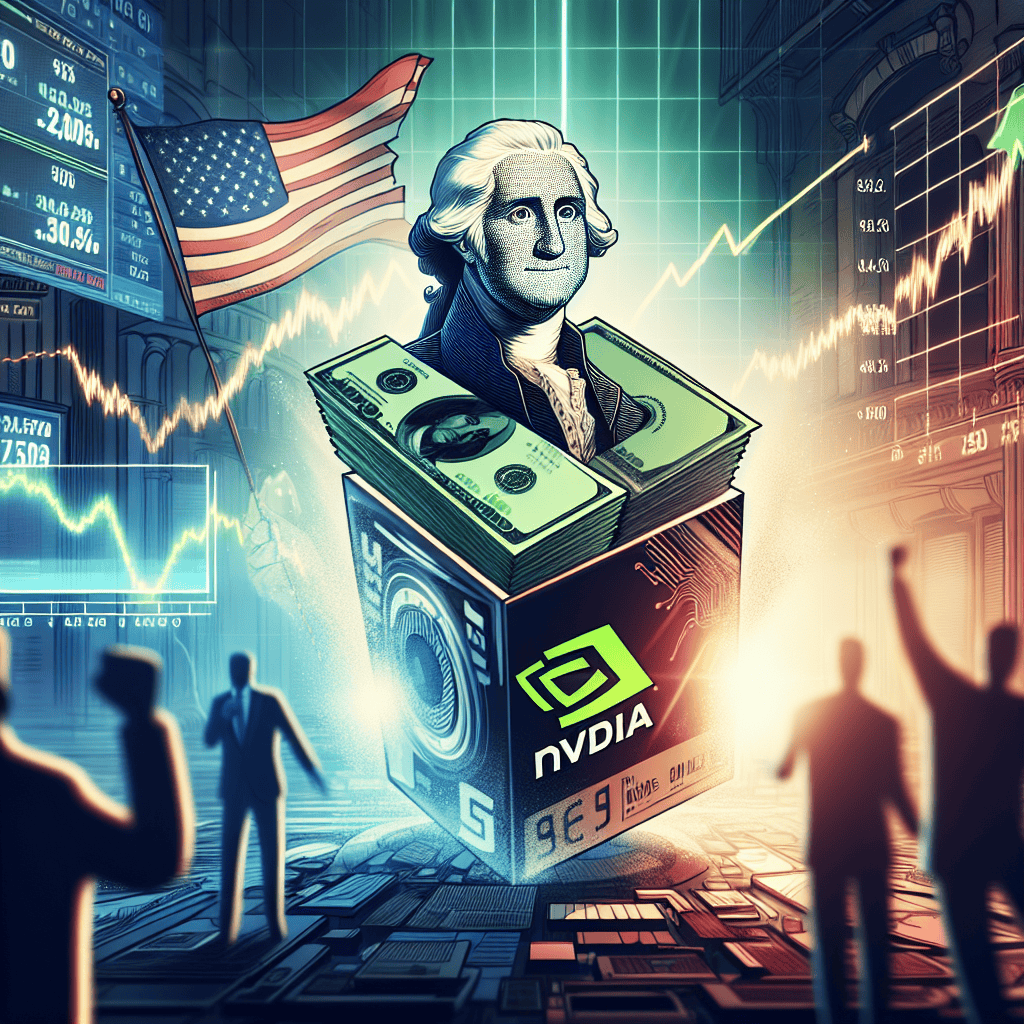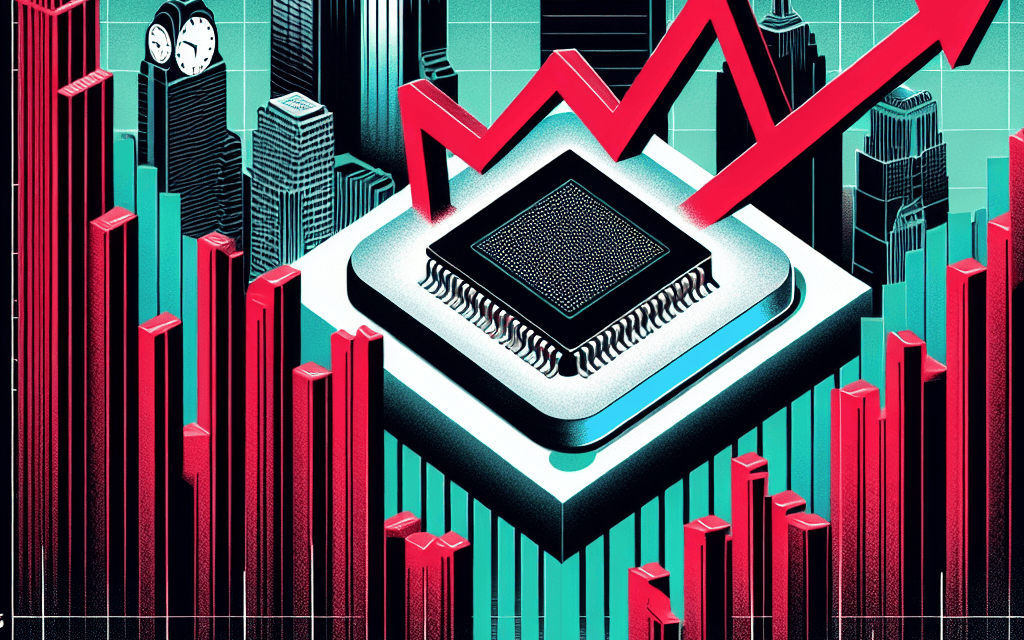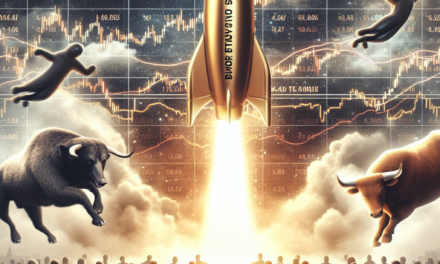“Market Jitters: Dow Futures Dip Pre-Election, S&P 500 Stars Shine, Nvidia Joins Dow Ranks”
Introduction
Dow Jones futures experienced a decline as the market braces for the upcoming election, reflecting investor caution amid potential political and economic shifts. Meanwhile, standout performers within the S&P 500 have captured attention, showcasing resilience and growth in a volatile environment. In a significant development, Nvidia, a leading player in the technology sector, is poised to join the Dow Jones Industrial Average, marking a notable inclusion that underscores the evolving landscape of the index. This transition highlights Nvidia’s growing influence and the broader trend of technology companies gaining prominence in traditional market benchmarks.
Impact Of Election Uncertainty On Dow Jones Futures
As the nation approaches a pivotal election, the financial markets are bracing for potential volatility, with Dow Jones futures experiencing a noticeable drop. This decline underscores the broader impact of election uncertainty on investor sentiment and market stability. Historically, elections have been periods of heightened market sensitivity, as investors grapple with the potential implications of new policies and leadership changes. The current environment is no exception, with market participants closely monitoring political developments and their potential economic repercussions.
The Dow Jones Industrial Average, a key barometer of the U.S. stock market, often reflects investor confidence or apprehension during such times. The recent dip in Dow Jones futures can be attributed to a confluence of factors, including concerns over potential shifts in fiscal policy, regulatory changes, and international trade relations that could arise from the election outcome. Investors are particularly wary of any abrupt changes that could disrupt the current economic trajectory, which has been marked by a gradual recovery from the pandemic-induced downturn.
In contrast, the S&P 500 has showcased certain standout performers that have managed to capture investor attention despite the overarching uncertainty. Companies within sectors such as technology, healthcare, and consumer goods have demonstrated resilience, buoyed by strong earnings reports and robust growth prospects. These sectors are often seen as more insulated from political fluctuations, providing a degree of stability amidst the broader market turbulence. As a result, they have become focal points for investors seeking to navigate the uncertain landscape.
Amidst these developments, Nvidia’s anticipated entry into the Dow Jones Industrial Average marks a significant milestone. The inclusion of this technology giant reflects the evolving composition of the index, which aims to represent the diverse sectors driving the modern economy. Nvidia’s addition is expected to bring a fresh dynamic to the Dow, given its leadership in areas such as artificial intelligence, gaming, and data centers. This move not only highlights the growing influence of technology companies in the market but also underscores the importance of innovation in shaping future economic growth.
The juxtaposition of election uncertainty with the strategic shifts within major indices like the Dow Jones presents a complex picture for investors. On one hand, the potential for policy changes and economic disruptions looms large, prompting caution and risk aversion. On the other hand, the resilience of certain sectors and the strategic inclusion of forward-looking companies like Nvidia offer a glimpse of optimism and opportunity. Navigating this landscape requires a nuanced understanding of both macroeconomic trends and individual company performance.
In conclusion, the drop in Dow Jones futures ahead of the election serves as a reminder of the intricate interplay between politics and markets. While uncertainty remains a defining feature of the current environment, the presence of standout performers in the S&P 500 and the strategic evolution of the Dow Jones Industrial Average provide a counterbalance. As investors weigh these factors, the ability to adapt and respond to changing conditions will be crucial in charting a course through this period of uncertainty. Ultimately, the outcome of the election will play a pivotal role in shaping the market’s trajectory, influencing both short-term movements and long-term trends.
Key S&P 500 Performers Amid Market Volatility
As the financial markets brace for the upcoming election, the Dow Jones futures have experienced a notable drop, reflecting the uncertainty that often accompanies such significant political events. This volatility is not isolated to the Dow; the S&P 500, a broader index that captures a wide array of industries, has also been subject to fluctuations. Amidst this backdrop of market instability, certain companies within the S&P 500 have managed to distinguish themselves, showcasing resilience and adaptability in the face of economic unpredictability.
One of the standout performers in the S&P 500 is a technology giant that has consistently demonstrated robust growth and innovation. This company has capitalized on the increasing demand for digital solutions, which has been accelerated by the global shift towards remote work and online services. Its strategic investments in cloud computing and artificial intelligence have not only bolstered its revenue streams but also positioned it as a leader in the tech sector. As investors seek stability, this company’s strong financial performance and forward-looking strategies have made it an attractive option.
In contrast, the energy sector within the S&P 500 has faced significant challenges, primarily due to fluctuating oil prices and the ongoing transition towards renewable energy sources. However, some energy companies have managed to navigate these hurdles by diversifying their portfolios and investing in sustainable energy projects. These efforts have not only mitigated risks associated with traditional energy markets but have also aligned with the growing emphasis on environmental, social, and governance (ESG) criteria among investors. As a result, these companies have maintained a competitive edge, even as the sector as a whole grapples with volatility.
Meanwhile, the healthcare sector has emerged as another area of interest within the S&P 500, driven by advancements in biotechnology and pharmaceuticals. Companies that have focused on innovative treatments and vaccines have seen their stock prices rise, reflecting investor confidence in their potential for long-term growth. The ongoing global health challenges have underscored the importance of medical research and development, further highlighting the value of companies that are at the forefront of these efforts.
As the market continues to navigate these turbulent times, Nvidia’s anticipated entry into the Dow Jones Industrial Average marks a significant development. Known for its cutting-edge graphics processing units (GPUs) and contributions to the fields of gaming, data centers, and artificial intelligence, Nvidia’s inclusion in the Dow is a testament to its influence and success. This move is expected to bring a fresh dynamic to the index, potentially attracting a new wave of investors who are keen on technology-driven growth.
In conclusion, while the Dow Jones futures may be experiencing a downturn ahead of the election, the S&P 500 offers a diverse landscape of companies that are thriving despite market volatility. From technology and healthcare to energy, these sectors highlight the adaptability and resilience of businesses that are well-positioned to capitalize on emerging trends. As investors navigate these uncertain times, the performance of key S&P 500 companies serves as a reminder of the opportunities that exist within a fluctuating market. With Nvidia set to join the Dow, the evolving composition of major indices continues to reflect the dynamic nature of the global economy.
Nvidia’s Anticipated Entry Into The Dow: What It Means For Investors
As the financial world braces for the upcoming election, the Dow Jones futures have experienced a noticeable drop, reflecting the market’s anticipation and uncertainty. Amidst this backdrop, Nvidia’s anticipated entry into the Dow Jones Industrial Average has captured the attention of investors and analysts alike. This development is not only significant for Nvidia but also holds broader implications for the market and investors. Understanding these implications requires a closer examination of Nvidia’s trajectory and the potential impact of its inclusion in the Dow.
Nvidia, a leading player in the semiconductor industry, has consistently demonstrated robust growth and innovation, particularly in areas such as artificial intelligence, gaming, and data centers. Its technological advancements and strategic acquisitions have positioned it as a formidable force in the tech sector. Consequently, Nvidia’s inclusion in the Dow is seen as a recognition of its influence and a testament to its financial performance. For investors, this move signals a shift in the composition of the Dow, reflecting the growing importance of technology companies in the broader economy.
The Dow Jones Industrial Average, traditionally composed of 30 significant publicly traded companies, serves as a barometer for the overall health of the U.S. stock market. Nvidia’s entry into this prestigious index underscores the evolving landscape of the market, where technology firms are increasingly driving growth and innovation. This shift is indicative of a broader trend where traditional industries are being complemented, and in some cases supplanted, by tech-driven enterprises. For investors, this transition presents both opportunities and challenges, as they must navigate a market that is becoming more reliant on technological advancements.
Moreover, Nvidia’s inclusion in the Dow is likely to attract increased attention from institutional investors, who often use the index as a benchmark for their portfolios. This heightened interest could lead to greater liquidity and potentially drive up Nvidia’s stock price, benefiting existing shareholders. However, it also necessitates a careful evaluation of Nvidia’s valuation and growth prospects, as the increased scrutiny could amplify market reactions to any fluctuations in its performance.
In addition to Nvidia’s anticipated entry into the Dow, the current market environment is characterized by the standout performance of certain S&P 500 companies. These firms have managed to thrive despite the prevailing economic uncertainties, showcasing resilience and adaptability. Their success stories provide valuable insights for investors seeking to identify potential opportunities amidst market volatility. By analyzing the strategies and innovations that have propelled these companies forward, investors can gain a deeper understanding of the factors driving success in today’s dynamic market.
As the election approaches, the interplay between political developments and market dynamics will continue to shape investor sentiment. The drop in Dow Jones futures serves as a reminder of the market’s sensitivity to external factors and the importance of staying informed and adaptable. For investors, Nvidia’s entry into the Dow and the performance of standout S&P 500 companies offer a glimpse into the future of the market, highlighting the critical role of technology and innovation in driving growth.
In conclusion, Nvidia’s anticipated inclusion in the Dow Jones Industrial Average marks a significant milestone for the company and the broader market. It reflects the increasing prominence of technology firms and underscores the need for investors to remain vigilant and responsive to changing market conditions. As the election looms, the evolving landscape presents both challenges and opportunities, emphasizing the importance of strategic decision-making in navigating the complexities of today’s financial environment.
How Political Events Influence Stock Market Trends

The stock market is a complex ecosystem influenced by a myriad of factors, with political events often playing a pivotal role in shaping market trends. As the Dow Jones futures drop ahead of an upcoming election, investors are keenly observing the potential implications of political shifts on their portfolios. Historically, elections have been periods of heightened volatility in the stock market, as uncertainty about future policies and leadership can lead to fluctuations in investor confidence. This phenomenon is not limited to the United States; globally, markets tend to react to political events, reflecting the interconnected nature of modern economies.
In the lead-up to an election, market participants often engage in speculative trading, attempting to predict the outcomes and adjust their strategies accordingly. This speculative behavior can lead to increased volatility, as seen in the recent drop in Dow Jones futures. Investors may be concerned about potential changes in fiscal policy, regulatory environments, and international relations, all of which can have significant impacts on corporate earnings and economic growth. Consequently, the stock market becomes a barometer for political sentiment, with indices like the Dow Jones and S&P 500 serving as indicators of investor confidence.
Amidst this backdrop of political uncertainty, certain standout companies within the S&P 500 have managed to capture the attention of investors. These companies often exhibit strong fundamentals, innovative business models, and resilience in the face of economic challenges. Highlighting these standouts provides insight into sectors that may thrive regardless of political outcomes. For instance, technology companies have consistently demonstrated robust performance, driven by ongoing digital transformation and increased demand for tech solutions. As a result, investors may look to these companies as safe havens during periods of political turbulence.
In a notable development, Nvidia, a leading player in the technology sector, is set to enter the Dow Jones Industrial Average. This inclusion reflects the growing importance of technology companies in the broader economy and underscores the sector’s resilience. Nvidia’s entry into the Dow is expected to bring a fresh dynamic to the index, potentially attracting new investors and altering the weightings of existing components. The move also highlights the evolving nature of the Dow, which has historically been dominated by industrial and financial companies. As technology continues to drive economic growth, its representation in major indices is likely to increase, further influencing market trends.
While political events undeniably impact stock market trends, it is essential for investors to maintain a long-term perspective. Short-term volatility, often exacerbated by political uncertainty, can obscure the underlying fundamentals of the market. By focusing on companies with strong growth prospects and sound financial health, investors can navigate the complexities of political events with greater confidence. Moreover, diversification across sectors and geographies can mitigate risks associated with political developments in any single region.
In conclusion, the interplay between political events and stock market trends is a dynamic and multifaceted relationship. As the Dow Jones futures drop ahead of an election, and with Nvidia set to enter the Dow, investors are reminded of the importance of staying informed and adaptable. By understanding the potential impacts of political shifts and identifying resilient companies, investors can better position themselves to weather the uncertainties of the market and capitalize on emerging opportunities.
Analyzing The Relationship Between Dow Futures And Election Outcomes
The relationship between Dow Jones futures and election outcomes has long been a subject of interest for investors and analysts alike. As the Dow Jones futures drop ahead of an upcoming election, it is crucial to understand the dynamics at play and how they might influence market behavior. Historically, elections have been periods of uncertainty, and markets tend to react to the potential for policy changes that could impact economic conditions. This uncertainty often leads to volatility in futures markets, as investors attempt to anticipate the direction of future government policies and their implications for the economy.
In the current scenario, the drop in Dow Jones futures can be attributed to a combination of factors, including investor anxiety over potential shifts in fiscal and monetary policies. As elections approach, market participants often reassess their portfolios, seeking to hedge against possible risks while positioning themselves to capitalize on opportunities that may arise from new policy directions. This behavior can lead to fluctuations in futures prices, as seen in the current market environment.
Moreover, the performance of the S&P 500, which often serves as a broader indicator of market sentiment, highlights standout sectors that may be particularly sensitive to election outcomes. For instance, sectors such as healthcare, energy, and technology are frequently in the spotlight during election cycles due to their susceptibility to regulatory changes. Investors closely monitor these sectors, as policy shifts could significantly impact their profitability and growth prospects. The S&P 500’s performance, therefore, provides valuable insights into which areas of the market are perceived as most vulnerable or promising in the context of the election.
In addition to these considerations, the impending inclusion of Nvidia into the Dow Jones Industrial Average adds another layer of complexity to the market dynamics. Nvidia’s entry into the Dow is a significant development, as it reflects the growing importance of technology companies in the modern economy. This inclusion is likely to attract increased attention from investors, potentially influencing trading patterns and contributing to the volatility observed in Dow futures. As a major player in the semiconductor industry, Nvidia’s performance and strategic direction could have far-reaching implications for the tech sector and the broader market.
Furthermore, the interplay between Dow futures and election outcomes is not solely a matter of domestic policy considerations. Global factors, such as trade relations and geopolitical tensions, also play a crucial role in shaping market expectations. Investors must navigate these complexities, balancing domestic political developments with international economic conditions. This multifaceted landscape requires a nuanced understanding of how various elements interact to influence market behavior.
In conclusion, the drop in Dow Jones futures ahead of the election underscores the intricate relationship between market sentiment and political developments. As investors grapple with uncertainty, they must consider a range of factors, from sector-specific vulnerabilities to broader economic trends. The inclusion of Nvidia in the Dow adds another dimension to this analysis, highlighting the evolving nature of the market and the importance of technology in shaping future economic prospects. By examining these dynamics, investors can better position themselves to navigate the challenges and opportunities presented by the intersection of market forces and political events.
S&P 500 Standouts: Companies To Watch During Election Season
As the election season approaches, the financial markets are poised for potential volatility, with Dow Jones futures experiencing a notable drop. This period of political uncertainty often leads investors to reassess their portfolios, seeking stability amidst the fluctuations. In this context, the S&P 500, a benchmark for the broader market, becomes a focal point for investors aiming to identify standout companies that may offer resilience or growth opportunities during these turbulent times.
Among the companies that have captured the attention of market analysts are those that have demonstrated robust performance and strategic positioning within their respective industries. These firms are not only navigating the current economic landscape effectively but are also poised to capitalize on emerging trends that could shape the post-election market environment. As such, they represent potential opportunities for investors looking to mitigate risks while seeking returns.
One of the key sectors that continue to draw interest is technology, with companies like Nvidia standing out due to their innovative capabilities and market leadership. Nvidia, known for its advanced graphics processing units (GPUs) and artificial intelligence (AI) technologies, is set to make a significant move by entering the Dow Jones Industrial Average. This inclusion underscores the growing importance of technology firms in the broader economic framework and highlights Nvidia’s role as a pivotal player in the tech industry. The company’s strategic investments in AI and data centers position it well to benefit from the increasing demand for digital transformation across various sectors.
Transitioning from technology to healthcare, another sector that remains in the spotlight is biotechnology. Companies within this space have been at the forefront of developing groundbreaking treatments and vaccines, particularly in response to global health challenges. As the election season unfolds, healthcare policies and regulatory changes could significantly impact these companies, making them crucial to watch. Investors are keenly observing firms that have a strong pipeline of innovative products and those that are adept at navigating the complex regulatory landscape.
In addition to technology and healthcare, consumer goods companies are also garnering attention. With shifts in consumer behavior driven by economic conditions and changing lifestyles, companies that can adapt to these trends are likely to perform well. Firms that have embraced e-commerce and digital marketing strategies are particularly well-positioned to capture market share. As consumer confidence fluctuates with political developments, these companies’ ability to maintain brand loyalty and meet evolving consumer demands will be critical.
Furthermore, the energy sector, often influenced by policy changes, is another area where investors are focusing their attention. The transition towards renewable energy sources and sustainable practices is a trend that continues to gain momentum. Companies that are leading the charge in clean energy innovation are likely to benefit from favorable policy shifts and increased investment in green technologies. As such, they represent potential long-term growth opportunities for investors who are mindful of environmental, social, and governance (ESG) factors.
In conclusion, as the election season progresses, the S&P 500 offers a diverse array of standout companies across various sectors that are worth monitoring. These firms not only exhibit strong fundamentals but also possess the strategic foresight to navigate the uncertainties of the current political and economic climate. By focusing on companies that are well-positioned to leverage emerging trends and adapt to changing conditions, investors can better manage risks and potentially enhance their portfolios during this pivotal period.
The Role Of Technology Stocks In Shaping The Dow’s Future
As the financial world braces for the upcoming election, the Dow Jones futures have experienced a noticeable drop, reflecting the market’s anticipation and uncertainty. This decline comes at a time when technology stocks are playing an increasingly pivotal role in shaping the future of the Dow Jones Industrial Average. The influence of these stocks is underscored by the recent announcement that Nvidia, a leading player in the tech industry, is set to join the Dow. This move highlights the growing importance of technology companies in the broader market landscape.
The inclusion of Nvidia in the Dow is a testament to the transformative impact that technology stocks have had on the market. Over the past decade, tech companies have consistently outperformed other sectors, driven by rapid innovation and the increasing digitization of the global economy. As a result, these companies have become integral to the performance of major indices, including the Dow. The addition of Nvidia, known for its advancements in graphics processing units and artificial intelligence, is expected to further bolster the tech presence within the index.
Meanwhile, the S&P 500 has also seen standout performances from several technology stocks, which have contributed significantly to its overall gains. Companies such as Apple, Microsoft, and Amazon have not only driven the index upward but have also set new benchmarks for growth and profitability. Their success underscores the critical role that technology plays in the modern economy, as these companies continue to innovate and expand their influence across various sectors.
The rise of technology stocks within these indices is not without its challenges, however. The volatility associated with tech stocks can lead to significant fluctuations in market performance, as evidenced by the recent drop in Dow Jones futures. Investors must navigate this volatility while considering the long-term potential of these companies. Moreover, the increasing concentration of tech stocks in major indices raises questions about diversification and the potential risks associated with over-reliance on a single sector.
Despite these challenges, the integration of technology stocks into the Dow and other indices reflects a broader trend towards embracing innovation and future growth potential. As the global economy continues to evolve, technology companies are likely to remain at the forefront of this transformation. Their ability to adapt to changing market conditions and drive new advancements will be crucial in shaping the future of the Dow and other major indices.
In conclusion, the recent drop in Dow Jones futures ahead of the election highlights the market’s sensitivity to external factors and the growing influence of technology stocks. The inclusion of Nvidia in the Dow serves as a reminder of the sector’s increasing prominence and its potential to drive future growth. As investors and analysts look to the future, the role of technology stocks in shaping the Dow’s trajectory will undoubtedly remain a focal point. Balancing the opportunities and risks associated with these stocks will be essential for navigating the complexities of the modern financial landscape.
Q&A
1. **What is the Dow Jones Futures Drop?**
– The Dow Jones Futures Drop refers to a decline in the futures contracts of the Dow Jones Industrial Average, indicating a potential decrease in the stock market when it opens.
2. **Why is the drop significant ahead of the election?**
– The drop is significant because elections can create uncertainty in the markets, and investors may react to potential policy changes or political instability.
3. **What are S&P 500 standouts?**
– S&P 500 standouts are companies within the S&P 500 index that have shown exceptional performance or notable activity, such as strong earnings or significant stock price movements.
4. **Why are S&P 500 standouts highlighted?**
– They are highlighted to provide investors with insights into which companies are performing well and may present investment opportunities or risks.
5. **What is Nvidia’s role in this context?**
– Nvidia is set to enter the Dow Jones Industrial Average, which is a significant event as it reflects the company’s growing importance and influence in the market.
6. **Why is Nvidia entering the Dow significant?**
– Nvidia entering the Dow is significant because it represents a shift in the index to include more technology-focused companies, reflecting changes in the economy and market trends.
7. **How might Nvidia’s inclusion in the Dow affect its stock?**
– Nvidia’s inclusion in the Dow could lead to increased visibility and demand for its stock, as index funds and investors tracking the Dow may need to purchase shares.
Conclusion
The drop in Dow Jones futures ahead of an election indicates market uncertainty, often driven by potential policy changes and economic impacts associated with the election outcome. The highlighted standouts in the S&P 500 suggest that certain companies are performing well despite broader market volatility, possibly due to strong fundamentals or sector-specific trends. Nvidia’s anticipated entry into the Dow reflects its growing significance and influence in the market, underscoring its robust performance and the increasing importance of technology companies in the broader economy. Overall, these developments suggest a dynamic market environment influenced by political events, sector performance, and the evolving composition of major indices.





